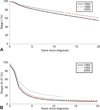Trends in relative survival for ovarian cancer from 1975 to 2011
- PMID: 26000505
- PMCID: PMC4484269
- DOI: 10.1097/AOG.0000000000000854
Trends in relative survival for ovarian cancer from 1975 to 2011
Abstract
Objective: To examine relative survival (a metric that incorporates changes in survival within a population) in women with ovarian cancer from 1975 to 2011.
Methods: Women diagnosed with ovarian cancer from 1975 to 2011 and recorded in the National Cancer Institute's Surveillance, Epidemiology, and End Results database were examined. Relative survival, estimated as the ratio of the observed survival of cancer patients (all-cause mortality) to the expected survival of a comparable group from the general population, was matched to the patients with the main factors that are considered to affect patient survival such as age, calendar time, and race. Hazard ratios were adjusted for age, race, year of diagnosis, time since diagnosis, and the interaction of age and years since diagnosis (except for stage II).
Results: A total of 49,932 women were identified. For stage I ovarian cancer, the adjusted excess hazard ratio for death in 2006 was 0.51 (95% confidence interval [CI] 0.41-0.63) compared with those diagnosed in 1975. The reduction in excess mortality remained significant when compared with 1980 and 1985. For women with stage III-IV tumors, the excess hazard of mortality was lower in 2006 compared with all other years of study ranging from 0.49 (95% CI 0.44-0.55) compared with 1975 to 0.93 (95% CI 0.87-0.99) relative to 2000. For women aged 50-59 years, 10-year relative survival was 0.85 (99% CI 0.61-0.95) for stage I disease and 0.18 (99% CI 0.10-0.27) for stage III-IV tumors. For women aged 60-69 years, the corresponding 10-year relative survival estimates were 0.89 (99% CI 0.58-0.98) and 0.15 (99% CI 0.09-0.21).
Conclusion: Relative survival has improved for all stages of ovarian cancer from 1975 to 2011.
Level of evidence: II.
Conflict of interest statement
The authors did not report any potential conflicts of interest.
Figures

Comment in
-
Trends in Relative Survival for Ovarian Cancer From 1975-2011.Obstet Gynecol. 2015 Oct;126(4):898. doi: 10.1097/AOG.0000000000001073. Obstet Gynecol. 2015. PMID: 26393445 No abstract available.
-
In Reply.Obstet Gynecol. 2015 Oct;126(4):898-899. doi: 10.1097/AOG.0000000000001078. Obstet Gynecol. 2015. PMID: 26393446 No abstract available.
References
-
- Young RC, Decker DG, Wharton JT, Piver MS, Sindelar WF, Edwards BK, et al. Staging laparotomy in early ovarian cancer. JAMA. 1983;250:3072–3076. - PubMed
-
- Griffiths CT. Surgical resection of tumor bulk in the primary treatment of ovarian carcinoma. Natl Cancer Inst Monogr. 1975;42:101–104. - PubMed
-
- McGuire WP, Hoskins WJ, Brady MF, Kucera PR, Partridge EE, Look KY, et al. Cyclophosphamide and cisplatin compared with paclitaxel and cisplatin in patients with stage III and stage IV ovarian cancer. N Engl J Med. 1996;334:1–6. - PubMed
-
- Armstrong DK, Bundy B, Wenzel L, Huang HQ, Baergen R, Lele S, et al. Intraperitoneal cisplatin and paclitaxel in ovarian cancer. N Engl J Med. 2006;354:34–43. - PubMed
-
- Katsumata N, Yasuda M, Takahashi F, Isonishi S, Jobo T, Aoki D, et al. Dose-dense paclitaxel once a week in combination with carboplatin every 3 weeks for advanced ovarian cancer: a phase 3, open-label, randomised controlled trial. Lancet. 2009;374:1331–1338. - PubMed
Publication types
MeSH terms
Grants and funding
LinkOut - more resources
Full Text Sources
Medical
Research Materials

